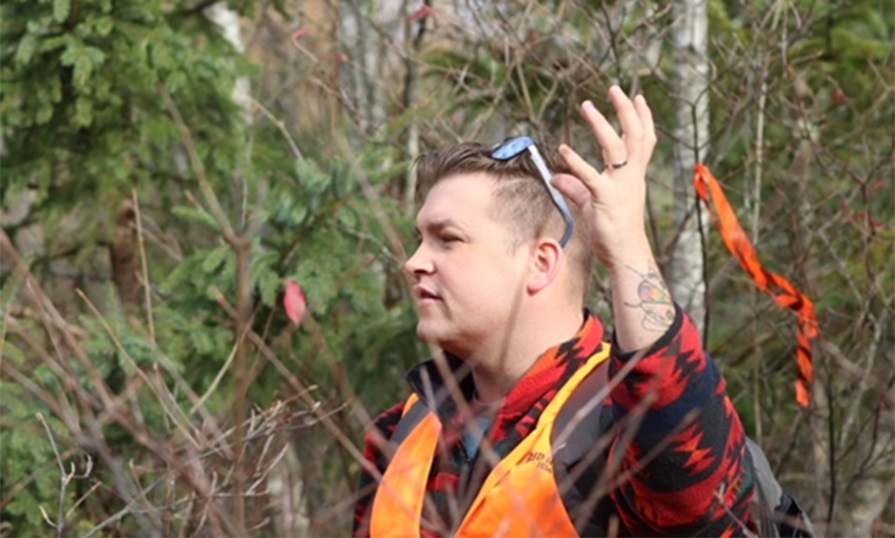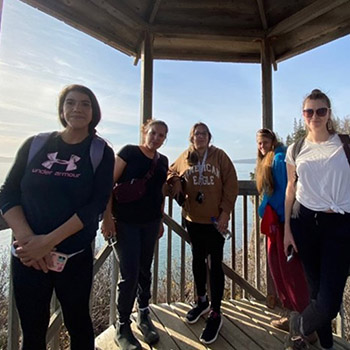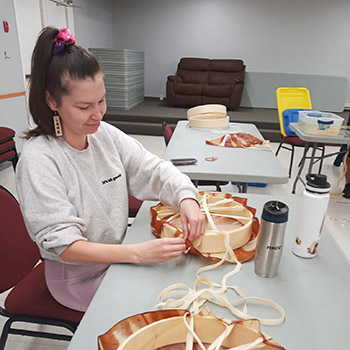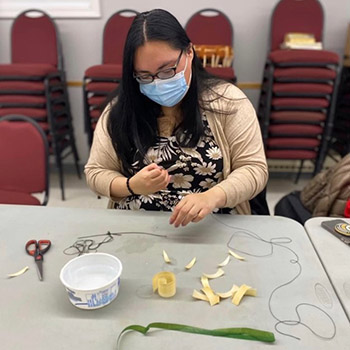Teli Ktuapsimk
Mi’kmaw Early Childhood Educators maintain connection to land and culture through weekend gathering

The Program
The Accelerated Poqji-kina’masulti’kw tel-kina’mujik mijua’ji’jk program, or Accelerated Mi’kmaw Early Childhood Education program, brings an Etuaptmumk (Two-Eyed Seeing) approach to how early childhood development and education are understood. Students study online and then gather twice a year for in-person land-based learning and connection.
Read on to learn about what students experienced as they gathered for one of the in-person sessions.
The Gathering
In November 2022, students were invited to a long weekend gathering aimed at providing them with the skills to use culture, land and language to process and heal. Arriving in We’kopekitk (Truro), students were greeted by their faculty, student support, mentors and Elder, Grandmother Marilyn Francis.
Students spent the evening completing the Indigenous Trauma Informed Empowerment Course, geared towards identifying vicarious trauma and the recycling of trauma. They explored colonial trauma, how trauma impacts the brain and how these traumas impact the next generations (intergenerational trauma). The students studied hands-on coping skills, including the importance of the “strong women’s” song, sung on the hand drum.
“Who knew we’d make a sisterhood in a matter of days.”
Nipuktuk – the place we go to heal
Rising early for an entire day on the land, students started their first full day outside by visiting Mi’kmawey Debert, one of the oldest ancestral sites of the Mi’kmaq. They learned how their ancestors lived amongst this area over 13,500 years ago, based on carbon dated material. A member of the Mi’kmawey Debert Cultural Centre team provided a tour of the grounds and discussed the upcoming plans for their new cultural centre.
Students spent part of the visit identifying plants, trees and medicines. They learned the legends of the medicines, their traditional names and their medicinal properties while learning lessons around the six-Mi’kmaq-worlds and how they relate to the modern day.
“I didn’t realize there were so many medicines in the woods.”
Finding Grandmother and Kluskap

Next, students visited Taqamiku’jk (Parrsboro), the home of Kluskap’s Grandmother Nukumi, where they explored the importance of water to understand that water is life. Students discovered Mi’kmaq legends as they relate to place, understanding that the legends serve as an entry point in unlocking and decoding their personal relationships to the natural environment.
After a steep two-kilometre hike over the mountain, students stood by the mountain’s edge to observe the home of Kluskap on Cape Split, directly across the bay.
As the tides changed, students explored the beaches for Kuntew (Rocks) – specifically gems and semi-precious stones – traditionally used by the Mi’kmaq. Students learned of the most precious stone of all: Grandfathers, a specific lava infused stone used for sweat lodge ceremonies. With the help of a few students, Grandmother Marilyn offered Tobacco, lit a fire, and gathered some Grandfathers for her planned sweat lodge ceremony.
Together, students discussed how these teachings are foundational in awakening the learning spirits of the children in their classrooms. They gained understanding of the uniqueness each child carries, learning how children are more than their physical selves, but are made up of their mental, emotional, and spiritual selves.

Making the drum
Pressing a cedar ring against a raw soaked hide, each student tightly weaves their lace, forming the prominent circular shape of their new hand drums, a highly anticipated activity. As part of the music and movement curriculum, students explored the history, teachings, and songs of the drum. Now in physical form, the students laugh over the ability to finally use it in their spaces, no longer needing to smack their legs or floor, forming the beat to hum their traditional songs.
“I am so honoured to finally own my own drum.”
Creating the Peaked Cap
Stringing beads and tacking against tanned hide, students learn the craft of beading in both traditional practice and modern wear. Completing their own design, each student created a pinned Mi’kmaw Peaked Cap, a gentle reminder of the matrilineal system of Mi’kmaq society. The event was instructed by Grandmother Marilyn, also giving each participant access to a listening ear and words of wisdom and love.
“It was the highlight of my weekend, sitting, beading, talking and connecting. I’ll remember this weekend for the rest of my life.”

Forming flowers
From a standing tree to small pieces of finely shaved white ash, traditional flowers of Mi’kma’ki are formed. Each petal gently cut and dyed in hues of purple and red. Students constructed their own wooden flowers enhancing that interconnectedness to land, Netukulit. Elder Bonnie furthers this interconnectedness by offering teachings around traditional Pītewey (tea). Offered a mint-infused pine flavour or the sweet aroma of the honey suckle, students steep their medicine of choice while they work.
“They’re more than our faculty and support, they’re our spiritual teachers too.”
Breaking cycles and building relationships
In the context of modernity, students participated in a ceremonial intergenerational trauma circle, highlighting the importance of accountability to self and unearthing what was prior to contact (i.e. communities so interconnected with the natural environment that each breath was a cohesive one).
Students expanded their interpersonal relations with one another as they unpacked the roles of community members – children, women, men, two-spirited, elders and warriors – and the role of culture. As part of the ceremony, students explored the removal of culture under the Indian Act, including the legacy of the Indian Residential Schools that saw over 150,000 Indigenous children forcibly removed from their homes and placed in residentials schools. They acknowledged the reality that the entire cohort of students, including faculty and student supports, are directly impacted, even today, because of what has been.
As a form of emergence and in the face of revitalization, students explored their role in breaking cycles. In becoming Dreamcatchers, students will be catching “good” and “bad” things, filtering what is fundamental in terms of understanding language, culture, traditions and place for building a strong and resilient next generation.
“I never imaged the weekend would be this powerful.”

